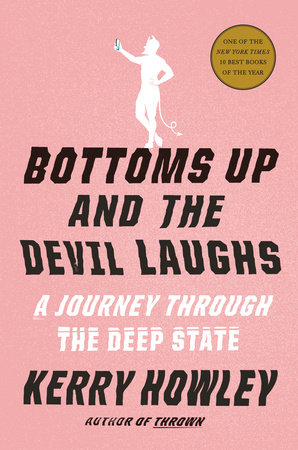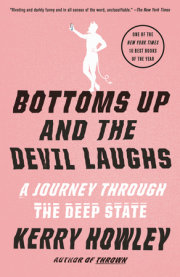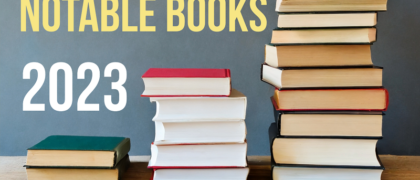A Note on Walls
In the course of writing this book, in the middle of its darkest, least human chapter, I lived alone in the West Texas desert. It was a trendy town in which wealthy people had gathered, purchased homes, and abandoned them. Sometimes they had also built walls, and it was fashionable to complain about these walls. The conversation at a dinner party turned, inevitably, to the misfortune of walls built by the wealthy, which violated the expansive openness of the desert landscape. We were not far from the border, after all, where a maniac wanted to build a wall; walls were classist, racist, wrong. “They all build walls,” someone said. “So ugly.” “That’s all recent.” “Things have really changed.” At which point a radiant older woman, an architect, spoke up. “That’s a very protestant idea,” she said. “This idea that you should be able to see inside someone else’s backyard. It’s an idea against ethnic clannishness.” This stopped me, being both obviously correct and so contrary to the force of my thinking a moment previous. We had presumed a right to see inside each compound. We had all of us turned an aesthetic preference into a morality. Or maybe it was that we had neutered a dark kind of morality into an aesthetic preference.
Joan Didion has praised the kind of home in which “you can close the door and cry until dinner,” which is to say, an architecture not so enamored by openness that it has failed to involve rooms. I kept this in mind as my husband and I were house shopping a few years ago. “Is this a house I can cry alone in?” I asked over and over. There was a house we rather liked. “But I don’t know,” my husband said, genuinely concerned. “Is there a room for crying?”
The morning after the desert dinner party I discovered, to my surprise, that I was pregnant. I was constructing, out of the food I had eaten at the dinner party, a wall of tough fibrous tissue around a spherical group of cells. I despaired many times, in the writing, about my ability to protect the thing I was growing from a world that had abandoned walls, that asserted its right to invade, to amass electrons against wholeness, that had forgotten what it was like to construct a self in the dark. But she is here now, in the world, and there is nothing to do but help her remember.
Surveillance Is Made of Dogs
Anyone can build a combat drone. If you build a drone for your little makeshift country, no one will be impressed. You could use the same engine they use for snowblowers, slap on a propeller, pour in some motor oil. We may think of drones as indestructible, ironclad, and this is the impression defense companies attempt to impart with the hard names they give machines they build: Predator drone, Reaper drone, Hunter drone; but in fact the original word, drone, is elegantly apt, and all of these are an attempt to mask the dumb delicacy it captures. Drones are cheap, flimsy, light little wisps of things, vulnerable to lost signals and sleepy pilots; vulnerable to gusts of wind and hard rain, lightning, ice; vulnerable even to themselves, as dropping a missile creates a thrust that threatens to spin a drone to the ground. You will send a drone whirling into the sand should you turn too hard into a breeze, or press the wrong button on your joystick; should you fly into an area of excessive electromagnetic noise or accidentally, as has happened to one American drone pilot, fly the drone upside down for a long while, oblivious. They slam into mountains, crash into other planes, fall into farms, sidewalks, waterways. Sometimes they simply go silent and float away, never to be found again. Their remains are cylinders with a wall punched out to reveal a hollow interior, as if the true drone had wormed its way out of this shell and flown on. Hundreds and hundreds of military drones we have lost this way, scattered across continents. It’s okay. They’re cheap. We make new ones.
What is impressive is not the drone, but the network that keeps it aloft. The satellites we rocket into the sky, bathing the globe in radio waves, invisible bouncy strands passing through you on their way back to our shallow bowled dishes, twenty feet across. We capture waves, of course, and we capture light, not only via drone, but in every way we can contrive to capture. The light and the waves come from Southeast Asia, the Middle East, Northern Africa, anywhere we can lay the hard bulk that sucks in the invisible. The waves and the light come from the United States, though much of that is technically illegal. They contain phone calls between children, YouTube tutorials, eviction notices, breakup emails, cancer diagnoses, love letters, selfies sent by text. Electrons stream through air and wire, underwater and overland. They whir back to us in search of embodiment.
On a trip with some of my dearest friends, undertaken largely but not exclusively for the reason of capturing flattering group selfies, every one of us had used up all the storage on our phones before we took a single photo. To take one selfie we had to delete, say three. By the time we went on our next trip together, everyone had upgraded phones. Now nothing would constrain us from taking pictures, all of which still exist, somewhere, because there is no incentive to delete them.
How much of the burden is in the way we watch ourselves? In the early years of the twenty-first century, everyone is amassing digital information but no one knows how to sort through it. Closets are stacked with old computers. It would be better, of course, to go through all of one’s photos and keep only those worth keeping, but the thought of this induces paralyzing exhaustion. This would involve decision-making, which is cognitively taxing. This would involve delving deep into our personal histories, our pasts, which may involve feelings we don’t feel like feeling. It’s best to just take another photograph. Keep building up the database. Throw it into the cloud, whatever that is. It’s slightly stressful to know that one’s personal database is bloated and disorganized, but you can’t see my cloud. It’s my burden to bear, my weight to carry; luckily, since I’m physically small, it’s only a cloud.
In the United States in the early years of the twenty-first century, this has been the approach intelligence agencies take toward information: Absorb everything, all of it, at once. Stash it somewhere. Worry about it later.
I wanted to know what surveillance was. I wanted to know what it was made of. More data has been created and stored since the year 2000 than in the entire previous course of humanity. The NSA’s upgraded phone is a giant warehouse, the size of six city blocks, sucking in water in the middle of a Utah desert. Inside are racks the size of refrigerators, and on the racks, more metal boxes, these the size of dinner plates. Inside those boxes are magnetic switches—zero one, zero one, one zero—the computer’s translation of all the words it is possible to whisper. A server farm is our age’s answer to the industrial factory: row upon row upon row of racks, 10,000 of them, autonomous, whirring, sucking in a small city’s worth of electricity and pouring out heat. This one cost two billion dollars to build; maintaining it and its generators costs millions more per year. Around it the NSA builds a fence, and on the fence they mount cameras. The sum total of human knowledge from the dawn of man to 2003 could be contained in five exabytes. The warehouse can probably hold twelve.
As you can imagine, you are not welcome on this piece of desert. But in the blueprints, one can see room for a kennel, where guard dogs must sleep, because American surveillance is partly made of electrons and partly made of tubes and partly made of dogs. The true enemy of data is not something against which dogs can protect. The enemy of all of this data, of all data, is heat. To cool the whirring racks, the NSA must pump in 1.2 million gallons of water per day, in the desert, in drought conditions. Data is physical. It can therefore be confronted.
In the early years of the twenty-first century, a Japanese woman promises to declutter our homes. She teaches us to prioritize space over things. She counsels us to clear our countertops. We throw out everything. Thrifters report that it is a glorious time to thrift; the shops are full of treasure. We take photos of our decluttered homes and save them in an increasingly anarchic digital space. The photos don’t take up any room. They don’t require sacrifice.
Most of us are good at not looking. Some people are very, very bad at it, which is perhaps a kind of evolutionary variance you’d want to have around. People who feel they must confront the nature of reality, whom we call “whistleblowers” or “traitors,” tend to feel that the rest of us should do the same, which makes those people annoying, because not looking is a skill, and after a while you too might lose the ability to not look. You might feel drawn to, say, NSA Georgia, because you wanted to understand the life of someone for whom the secret had become mundane. These pages are a strange history of a world burying itself in isolated fragments, “information,” data, the products of surveillance, and the twenty years in which these fragments come to be confused for fact. It is a polemic against memory cast into print.
My first real job was at a newspaper in Myanmar, which is and was a military dictatorship closed to most foreigners. I was twenty-one and never more visible; the state was watching, and so were the neighbors. The newspaper was called The Myanmar Times and Business Review, and it was run by a vulgar portly Australian. Before we could publish anything, we faxed what we had written to a censor, who faxed back the copy with big black X’s across it. You could then call the censor, whose name was Way Lin, and argue with him, at which point he would give reasons that your fluff piece on Halloween was inadmissible (ghost stories were illegal), or your profile of a rickshaw driver was axed (a driver with a degree in history suggested economic stagnation). Once, I met Way Lin at a party. He was friendly and eager to be liked. From this early experience I took a lesson in tonal complexity. What was ominous in the abstract was likely to be, in its specificities, absurd.
Being a woman is a way of being unseen, and this invisibility renders a certain confidence, a certain obliviousness to boundaries. To get to the NSA’s Whitelaw Building, I needed access to Fort Gordon, an army base. I parked at a visitor’s center. I explained that I was a professor doing research, which was true, and received a pass. Fort Gordon is a bleak, overgrown, dated brick affair. The architecture is sometimes brick riot-proof high school and sometimes socialist-cheap and occasionally horror-movie funhouse, as with the weathered “Bingo Palace” I passed as I circled and circled and searched for something that resembled the drawings I had seen. I felt the dirt road beneath my tires as I pulled behind some temporary buildings and passed a green scrubby field on which I may have seen some horses. There were massive satellite dishes surrounded by barbed wire. There were uniformed troops in formation. I saw nothing to contradict the idea that it was 1975. And then, in the distance, the $286 million, 604,000-square-foot Whitelaw Building, more concert hall than facility, gleaming and white and gently, expensively curved. It looked like a giant piece of consumer technology newly unwrapped. It did not look like it had been built. It looked like it had landed.
I walked up to some equally designed outdoor turnstiles, sleek metal detectors on which were posted signs: no cell phones. no thumb drives. An SUV pulled up with a police officer inside; she demanded my license and as I handed it to her I saw her notepad read “woman in a burgundy top.” I hadn’t thought of it as burgundy. As I sat on a patch of grass in the sun, increasingly hot, I worried about sun damage to my face, which is to say I was thinking about wrinkles as a second SUV pulled up. They wanted my phone. I asked if I could refuse, and they said no. The police officer called these new men “special agents,” though when I asked a guy for his title, he declined to say. There were two officials, then three, then six, and they were “just trying to figure out what’s going on.” I asked a few times if I could leave and was told I could not in fact leave; I asked if I was under arrest and told no, this was “investigatory detention.”
They asked me whether I would talk to the media and I said I didn’t know. They asked me who I was writing for and I said I didn’t know, who could say where this would end up, maybe Glimmer Train, a literary journal. I do not know why, when stressed, my instinct is to become more annoying. “Glimmer Train,” wrote the special agent on his special pad. They conferred away from me. The sun beat down and I continued to think about fine lines. “Who in the media will you speak to?” an agent asked for the third time. “I am the media,” I said grandly. To my surprise, they liked this answer; it involved a definable category. I was then turned over to a third jurisdictional authority, military police. I do not know how much time all of this took. I only know that in that thirty minutes or hour or two hours something shifted, because as I sat on that patch of grass I looked not at the building but at the parking lot. I looked at the cars: Jettas and Camrys. Thousands of regular people worked here. Thousands of middle-class people drove from their homes every day and parked here and went home and never told their mothers where they’d been. The eye is not always a metaphor. Surveillance, of course, is made of us.
Copyright © 2023 by Kerry Howley. All rights reserved. No part of this excerpt may be reproduced or reprinted without permission in writing from the publisher.







